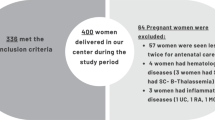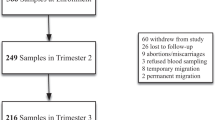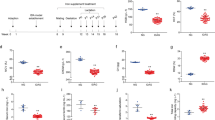Abstract
Iron deficiency is the most common cause of anemia in pregnancy. Pregnant women with anemia are, in general, exclusively treated with iron supplementation. We observed that several pregnant women with anemia who were nonresponsive to iron supplementation also had vitamin B6 deficiency, and that anemia in these cases improved with the administration of vitamin B6. Our prospective study in healthy pregnant women showed that blood levels of iron, ferritin and vitamin B6, in particular, fell to the lower limit of the nonpregnant reference range by the third trimester. We conclude that it is important to take into account the deficiency of vitamin B6 besides iron in the evaluation of anemia during pregnancy.
This is a preview of subscription content, access via your institution
Access options
Subscribe to this journal
Receive 12 print issues and online access
$259.00 per year
only $21.58 per issue
Buy this article
- Purchase on Springer Link
- Instant access to full article PDF
Prices may be subject to local taxes which are calculated during checkout

Similar content being viewed by others
References
Awad Jr WM (2006). Iron and heme metabolism. Heme biosynthesis. In: Delvin TM (ed). Textbook of Biochemistry with Clinical Correlations, 6th edn. Wiley-Liss (Wiley and Sons, Inc.: Hoboken, NJ), pp 833–840.
Barnard HC, de Kock JJ, Vermaak WJ, Potgieter GM (1987). A new perspective in the assessment of vitamin B-6 nutritional status during pregnancy in humans. J Nutr 117, 1303–1306.
Institute of Medicine (1998). Vitamin B6. Dietary Reference Intakes for Thiamin, Riboflavin, Niacin, Vitamin B6, Folate, Vitamin B12, Pantothenic Acid, Biotin, and Choline. A report of the Standing Committee on the Scientific Evaluation of Dietary Reference Intakes and its Panel on Folate, Other B Vitamins, and Choline and Subcommittee on Upper Reference Levels of Nutrients. National Academy Press: Washington, DC, pp 150–195.
Letsky EA (2002). Blood volume, haematinics, anaemia. In: de Swiet M (ed). Medical Disorders in Obstetric Practice 4th edn. Blackwell: Malden, pp 29–60.
Lone FW, Qureshi RN, Emmanuel F (2004). Maternal anaemia and its impact on perinatal outcome in a tertiary care hospital in Pakistan. East Mediterr Health J 10, 801–807.
Ubbink JB, Serfontein WJ, de Villiers LS (1985). Stability of pyridoxal-5-phosphate semicarbazone: applications in plasma vitamin B6 analysis and population surveys of vitamin B6 nutritional status. J Chromatogr 342, 277–284.
World Health Organization (1992). The Prevalence of Anaemia in Women: A Tabulation of Available Information (WHO/MCH/MSM/92), 2nd edn. WHO, Maternal Health and Safe Motherhood Programme, Division of Family Health: Geneva.
Acknowledgements
This work was supported by the National Hospital Organization (Japan).
Author information
Authors and Affiliations
Corresponding author
Rights and permissions
About this article
Cite this article
Hisano, M., Suzuki, R., Sago, H. et al. Vitamin B6 deficiency and anemia in pregnancy. Eur J Clin Nutr 64, 221–223 (2010). https://doi.org/10.1038/ejcn.2009.125
Received:
Revised:
Accepted:
Published:
Issue Date:
DOI: https://doi.org/10.1038/ejcn.2009.125
Keywords
This article is cited by
-
Association of maternal BMI during early pregnancy with infant anemia: a large Chinese birth cohort
Nutrition & Metabolism (2020)
-
Anemia associated with asymptomatic malaria among pregnant women in the rural surroundings of Arba Minch Town, South Ethiopia
BMC Research Notes (2015)
-
Microcytic anemia in a pregnant woman: beyond iron deficiency
International Journal of Hematology (2015)
-
Anemia before pregnancy and risk of preterm birth, low birth weight and small-for-gestational-age birth in Korean women
European Journal of Clinical Nutrition (2013)



